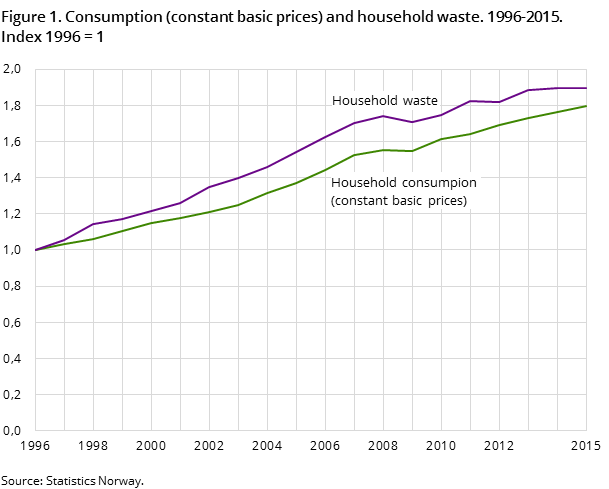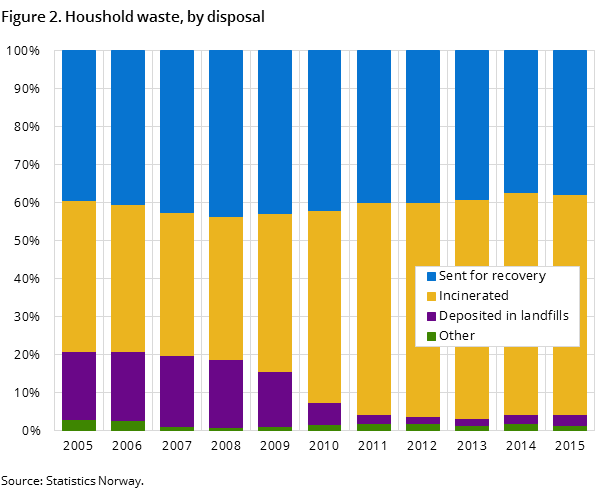Content
Published:
This is an archived release.
No changes in the waste amounts
Municipalities handled 2.3 million tonnes of household waste in 2015, about the same as in 2014. On average, each inhabitant generated 438 kg of household waste in 2015. That is the same as in 2014.
| Total | Per cent | ||||
|---|---|---|---|---|---|
| 2009 | 2014 | 2015 | 2009 - 2015 | 2014 - 2015 | |
| 1The figures have been adjusted to correct for interference of industrial waste in household waste | |||||
| 2Sent to material recovery includes composting and fermentation | |||||
| Corrected 24 June 2016. | |||||
| Total 1 000 tonnes | 2 039 | 2 264 | 2 288 | 12 | 1 |
| Kg per inhabitant | 420 | 438 | 439 | 5 | 0 |
| Sent to material recovery. 1000 tonnes.2 | 876 | 846 | 867 | -1 | 3 |
| Sent to material recovery. Kg per inhabitant.2 | 180 | 164 | 166 | -8 | 1 |
| Income from fees per inhabitant (NOK) | 839 | 942 | 953 | 14 | 1 |


This is still double the volume of 20 years ago. On the other hand, sorting of waste is also 6 times that of 20 years ago.
Waste amount increasing less than consumption
The figures show a correlation between consumption and waste generation. In the years up to 2008, the amount of household waste increased on average by 5 per cent each year, which was more than the consumption volume. In the last five years, the increase in average waste amount was less than the consumption volume. From 2014 to 2015, consumption increased by 2.0 per cent, whilst the waste generation increased by 1.1 per cent.
For every NOK 1 000 spent on consumption, Norwegians generate 2 kg of household waste.
The rate of material recovery is increasing
When waste for biogas production and composting are both included in the material recovery calculation, there is a small increase in the amounts of waste for material recovery. The material recovery then amounts to 870 000 tonnes or 38 per cent of all household waste for 2015. This is up one per cent from 2014, and most of the increase is due to 13 000 more park and gardening waste being sent for composting.
More food waste for biogas production
In 2015, about 180 000 tonnes of food waste and other wet organic material was sorted out in the households. Composting of food waste decreased by 14 000 tonnes, while the amount of food waste delivered for biogas production increased by 13 000 tonnes. In about 130 of Norway’s 428 municipalities the food waste is delivered together with mixed waste for incineration.
As for other materials, wood waste constituted the largest amount sorted for recovery, with around 280 000 tonnes. Paper and cardboard decreased for the fourth year in a row. The amounts decreased by 7 000 tonnes from 2014 to 2015. The amounts of mixed waste decreased by 8 000 tonnes from 2014 to 2015 and amounted to 986 000 tonnes in 2015. Out of this, 160 000 tonnes of mixed waste was exported for energy recovery.
Fraction of recovered waste unchanged
The waste sent to energy and material recovery constitutes 1.9 million tonnes, or 82 per cent of all household waste in 2015. This is the same as in 2014, but 11 percentage points more than in 2005.
Fewer climate gas emissions from waste
Figures show that the ban on depositing organically degradable material is working. Even though the amounts of waste deposited are increasing, the amounts of climate gasses from the waste are decreasing. As less organic waste is deposited and more is recycled, just under 1 million tonnes of CO2-equivalents, or 2 per cent of all climate gas emissions results form waste handling each year. Most of this emission is from waste deposited as far back as 40 years ago.
Svalbard generates less waste
The inhabitants in Longyearbyen on average throw away 170 kg of household waste. Mainland inhabitants discard more than twice as much in a year. All households in Longyearbyen have installed food waste disposers. This reduces the waste amount. Other explanations for the low amounts of waste could be that many inhabitants do not stay for very long or they live in small apartments. About 80 per cent of the waste from Svalbard is sent for energy recovery on the mainland.
About average in Europe
Norway generated 423 kg of municipal waste per capita in 2014, which is 50 kg less than the European average. Municipal waste is the sum of waste from households and the household-like waste from industries handled by the municipalities. As of 2014, waste from construction and demolition activities in the households is not included in the reported figures, and the numbers are therefore not comparable to earlier years.
Comparisons between countries may be uncertain since the coverage and managing of municipal waste varies within the EU.
Fee calculation basis unchanged
Costs in the municipal waste sector are covered by fees paid by the users of the service. Regulations stipulate that fees shall cover all the costs in the municipal waste service, and cannot exceed the actual costs for providing that service, i.e. self cost principle. Accurately calculating income from fees to cover the real calculation basis in a single year is complicated. The municipalities are therefore allowed to decide on fee levels so that income from fees over a five-year period equals the fee calculation basis.
For 2015, the income per inhabitant from the fees has increased by about 1 per cent compared to 2014. The income per inhabitant from the fees has increased by 4 per cent in the period 2011-2015.
The income from fees in 2015 was about 8 per cent lower than the fee calculation basis for that year. For the whole five-year period from 2011 to 2015, total income from fees was about 5per cent lower than the fee calculation basis.
The fee calculation basis increased by17 per cent from 2011 to 2015, while income from fees has increased by 9 per cent in the same period.
Recovery targetsOpen and readClose
There is a national goal of 80 per cent recovery. This goal however, pertains to all waste and not only household waste. The goals were last updated in a waste strategy from 2013.
In 2012, the average share of energy recovery was 78 per cent. The numbers for 2014 are calculated based on the same rate.
Textiles for reuse are no longer counted as wasteOpen and readClose
From 2011 onwards, textiles for reuse are no longer counted as waste. This causes a break in the time series, and the total amount of household waste is about one per cent lower than if the textiles for reuse were included.
Contact
-
Camilla Skjerpen
E-mail: camilla.skjerpen@ssb.no
tel.: (+47) 48 22 72 14
-
Mona E. Onstad
E-mail: mona.onstad@ssb.no
tel.: (+47) 48 59 61 86
